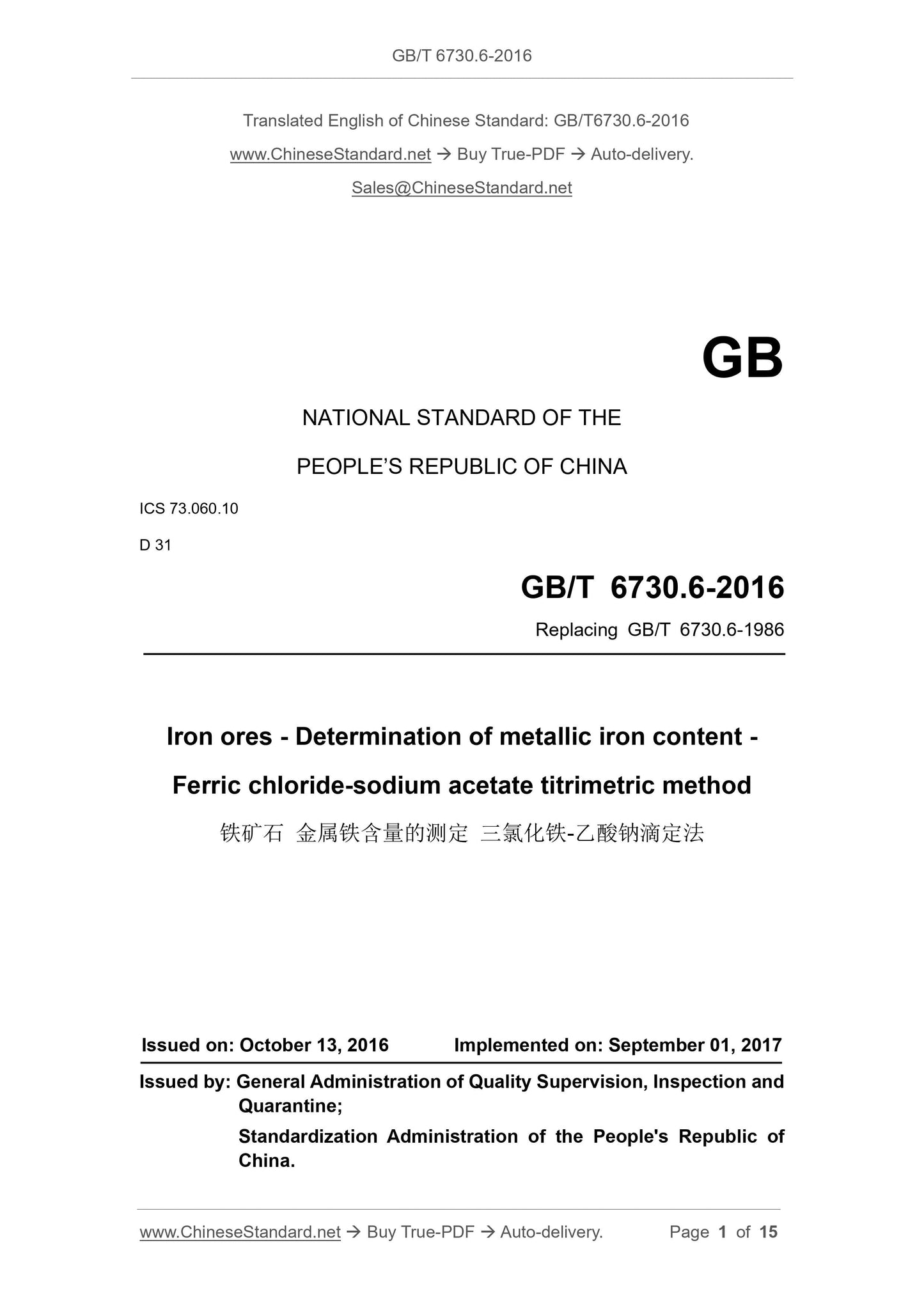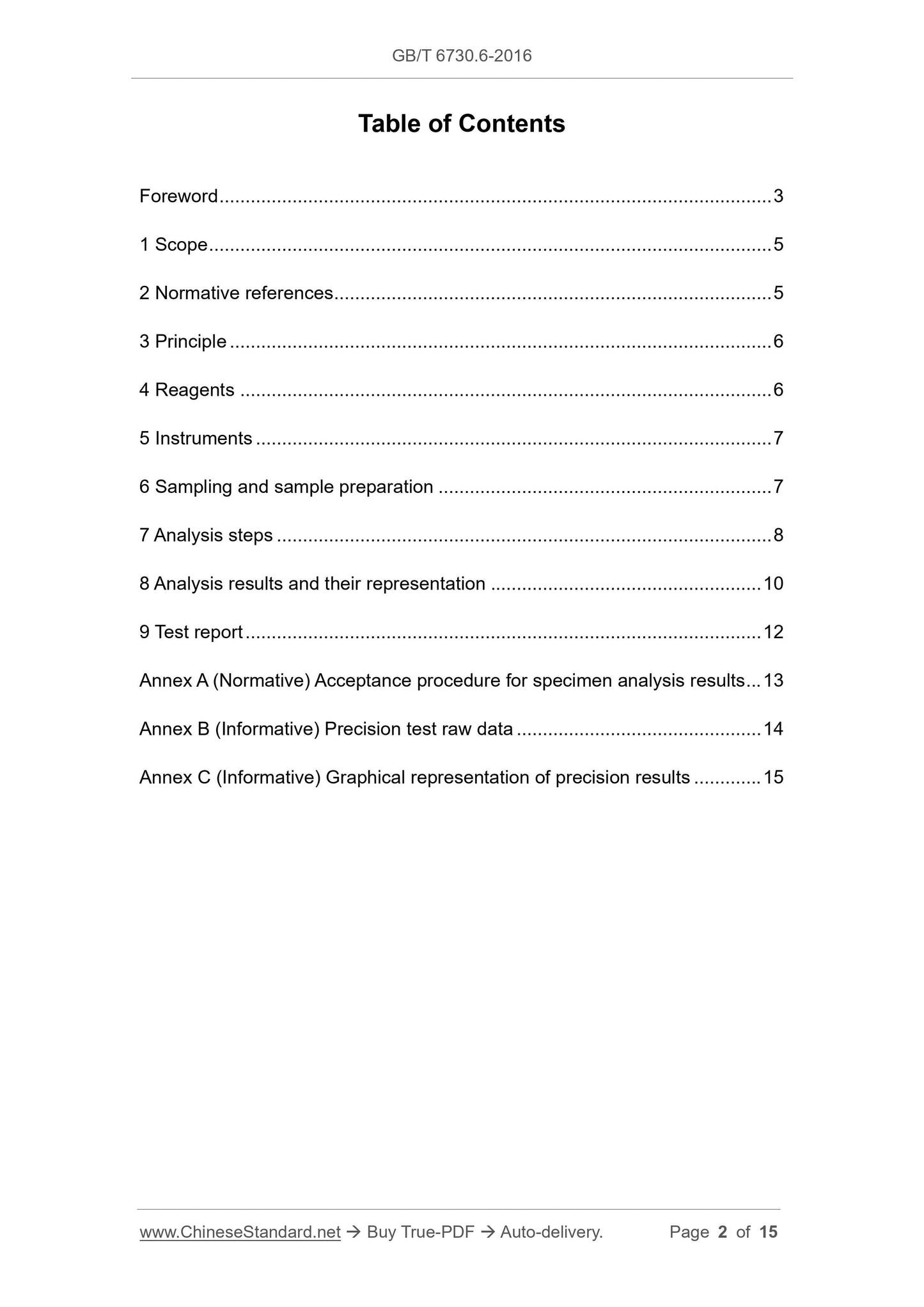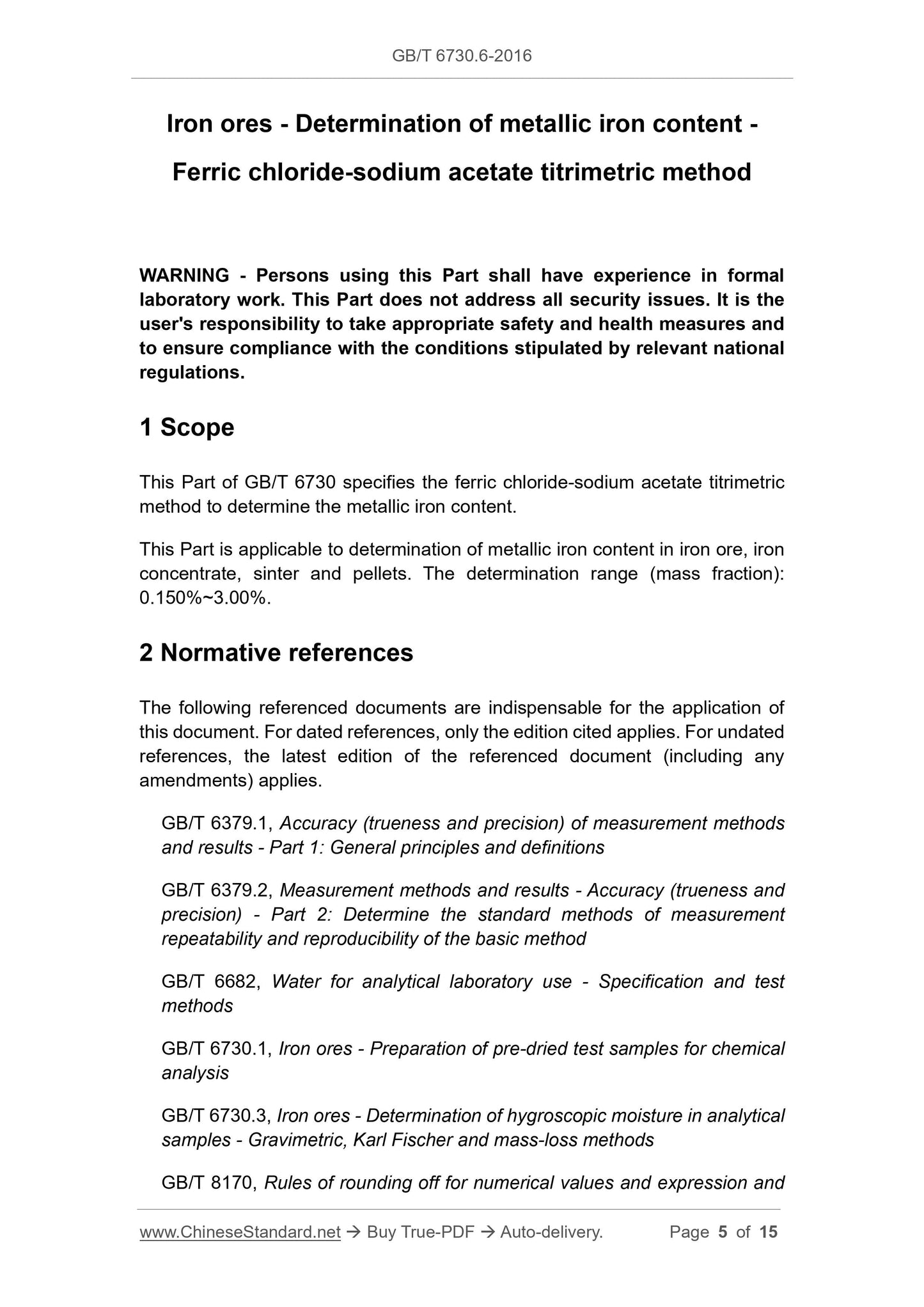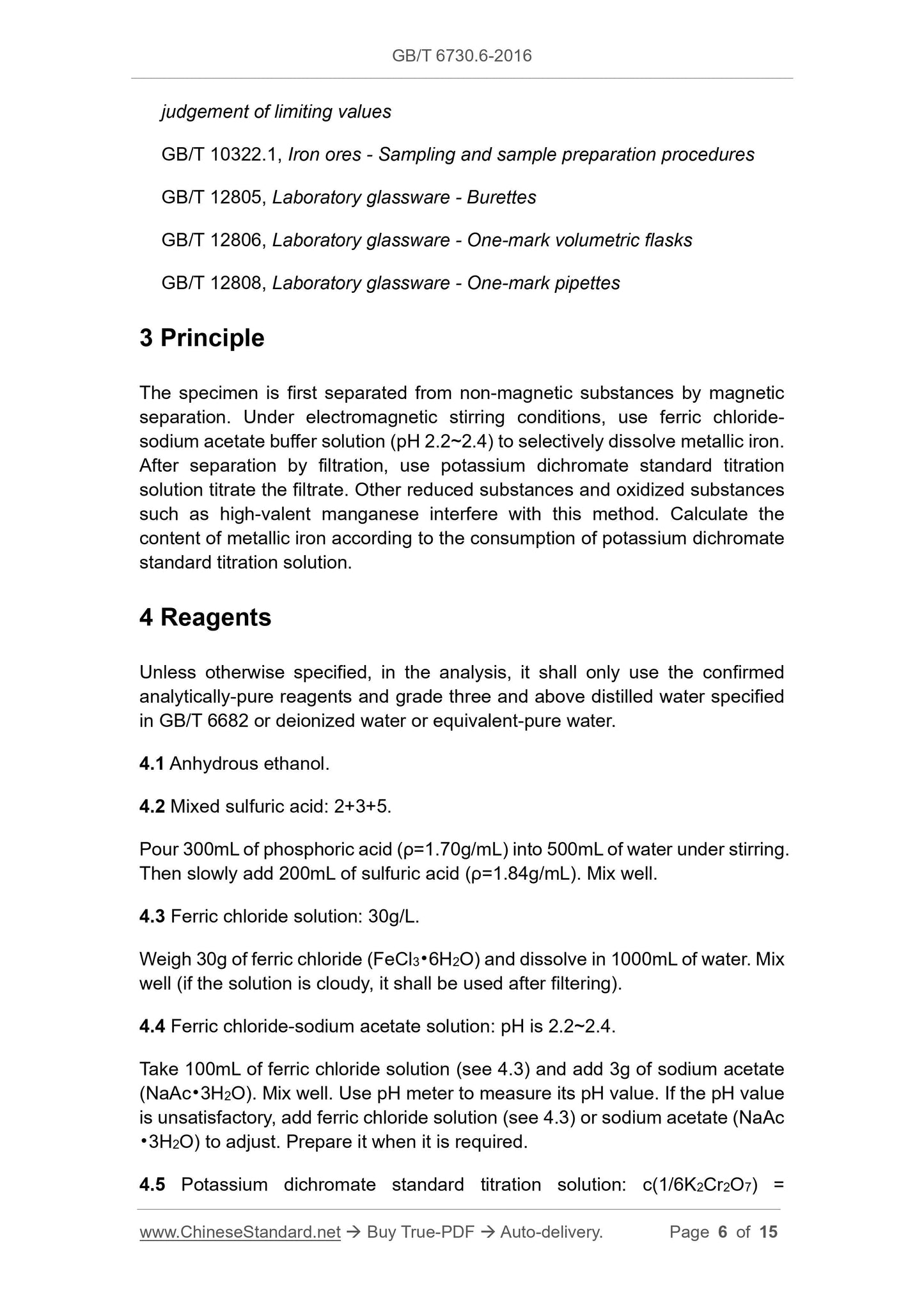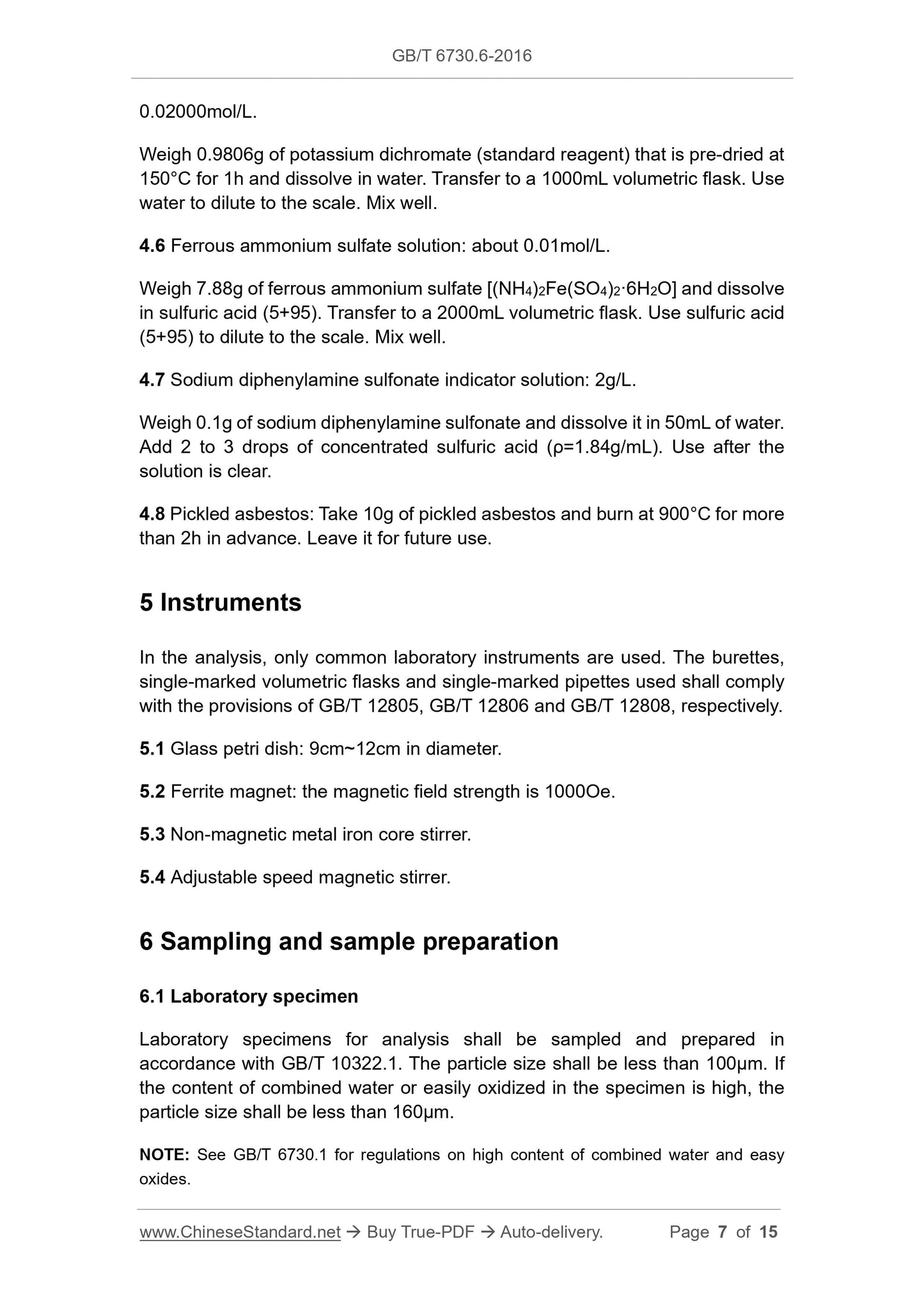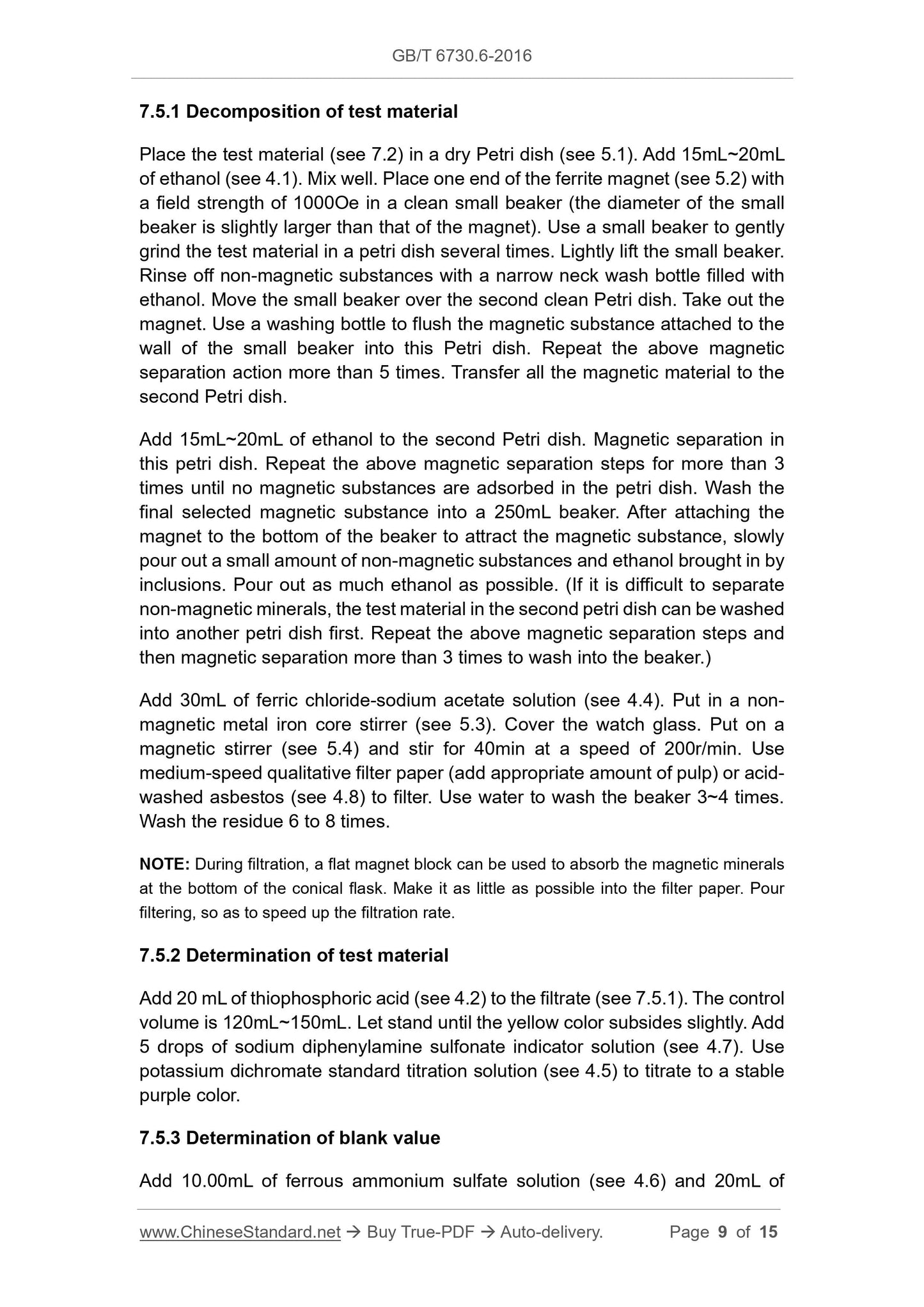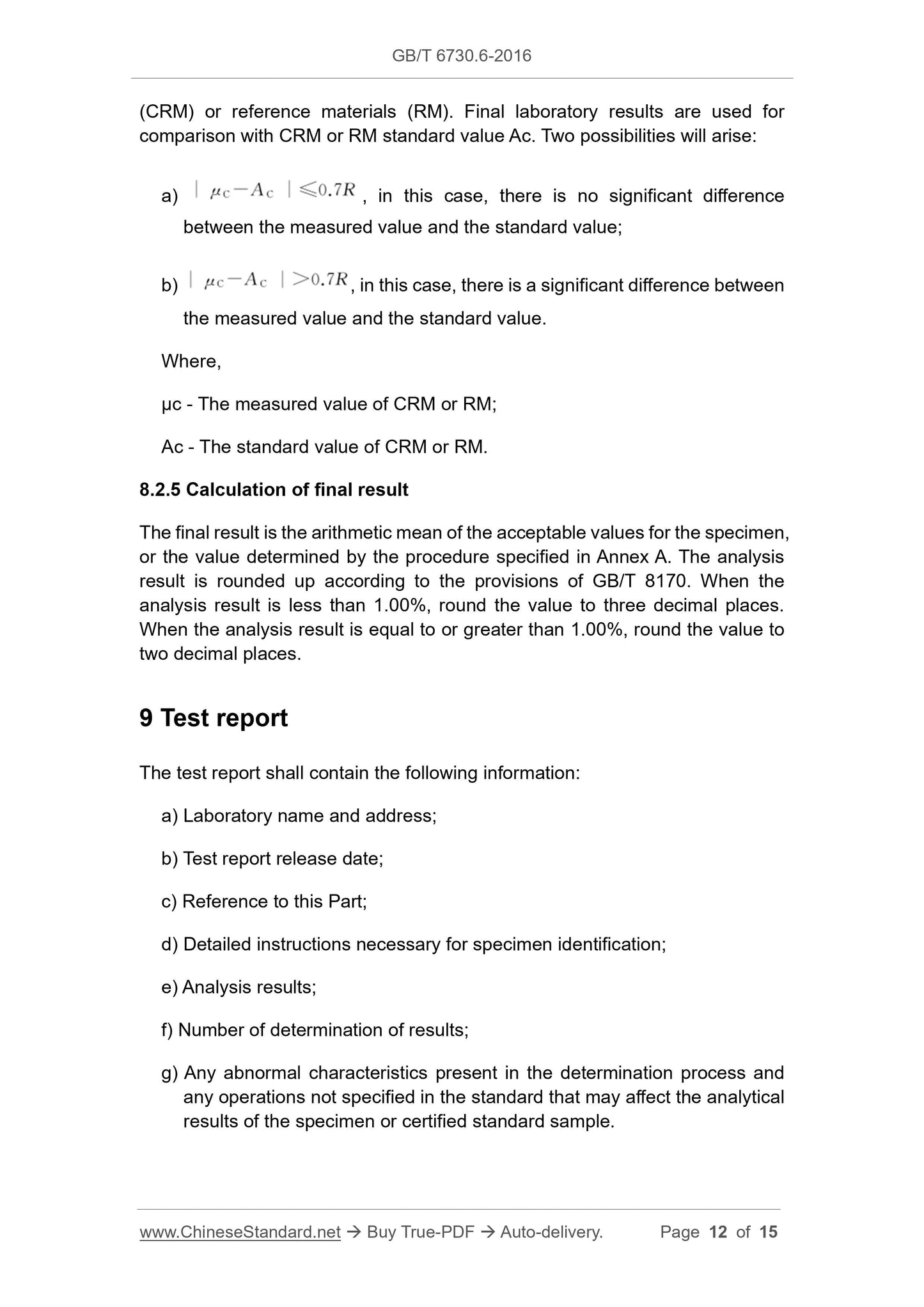PayPal, credit cards. Download editable-PDF & invoice in 1 second!
GB/T 6730.6-2016 English PDF (GBT6730.6-2016)
GB/T 6730.6-2016 English PDF (GBT6730.6-2016)
Precio habitual
$170.00 USD
Precio habitual
Precio de oferta
$170.00 USD
Precio unitario
/
por
Los gastos de envío se calculan en la pantalla de pago.
No se pudo cargar la disponibilidad de retiro
Delivery: 3 seconds. Download true-PDF + Invoice.
Get QUOTATION in 1-minute: Click GB/T 6730.6-2016
Historical versions: GB/T 6730.6-2016
Preview True-PDF (Reload/Scroll if blank)
GB/T 6730.6-2016: Iron ores -- Determination of metallic iron content -- Ferric chloride-sodium acetate titrimetric method
GB/T 6730.6-2016
GB
NATIONAL STANDARD OF THE
PEOPLE’S REPUBLIC OF CHINA
ICS 73.060.10
D 31
Replacing GB/T 6730.6-1986
Iron ores - Determination of metallic iron content -
Ferric chloride-sodium acetate titrimetric method
ISSUED ON: OCTOBER 13, 2016
IMPLEMENTED ON: SEPTEMBER 01, 2017
Issued by: General Administration of Quality Supervision, Inspection and
Quarantine;
Standardization Administration of the People's Republic of
China.
Table of Contents
Foreword ... 3
1 Scope ... 5
2 Normative references ... 5
3 Principle ... 6
4 Reagents ... 6
5 Instruments ... 7
6 Sampling and sample preparation ... 7
7 Analysis steps ... 8
8 Analysis results and their representation ... 10
9 Test report ... 12
Annex A (Normative) Acceptance procedure for specimen analysis results ... 13
Annex B (Informative) Precision test raw data ... 14
Annex C (Informative) Graphical representation of precision results ... 15
Iron ores - Determination of metallic iron content -
Ferric chloride-sodium acetate titrimetric method
WARNING - Persons using this Part shall have experience in formal
laboratory work. This Part does not address all security issues. It is the
user's responsibility to take appropriate safety and health measures and
to ensure compliance with the conditions stipulated by relevant national
regulations.
1 Scope
This Part of GB/T 6730 specifies the ferric chloride-sodium acetate titrimetric
method to determine the metallic iron content.
This Part is applicable to determination of metallic iron content in iron ore, iron
concentrate, sinter and pellets. The determination range (mass fraction):
0.150%~3.00%.
2 Normative references
The following referenced documents are indispensable for the application of
this document. For dated references, only the edition cited applies. For undated
references, the latest edition of the referenced document (including any
amendments) applies.
GB/T 6379.1, Accuracy (trueness and precision) of measurement methods
and results - Part 1: General principles and definitions
GB/T 6379.2, Measurement methods and results - Accuracy (trueness and
precision) - Part 2: Determine the standard methods of measurement
repeatability and reproducibility of the basic method
GB/T 6682, Water for analytical laboratory use - Specification and test
methods
GB/T 6730.1, Iron ores - Preparation of pre-dried test samples for chemical
analysis
GB/T 6730.3, Iron ores - Determination of hygroscopic moisture in analytical
samples - Gravimetric, Karl Fischer and mass-loss methods
GB/T 8170, Rules of rounding off for numerical values and expression and
judgement of limiting values
GB/T 10322.1, Iron ores - Sampling and sample preparation procedures
GB/T 12805, Laboratory glassware - Burettes
GB/T 12806, Laboratory glassware - One-mark volumetric flasks
GB/T 12808, Laboratory glassware - One-mark pipettes
3 Principle
The specimen is first separated from non-magnetic substances by magnetic
separation. Under electromagnetic stirring conditions, use ferric chloride-
sodium acetate buffer solution (pH 2.2~2.4) to selectively dissolve metallic iron.
After separation by filtration, use potassium dichromate standard titration
solution titrate the filtrate. Other reduced substances and oxidized substances
such as high-valent manganese interfere with this method. Calculate the
content of metallic iron according to the consumption of potassium dichromate
standard titration solution.
4 Reagents
Unless otherwise specified, in the analysis, it shall only use the confirmed
analytically-pure reagents and grade three and above distilled water specified
in GB/T 6682 or deionized water or equivalent-pure water.
4.1 Anhydrous ethanol.
4.2 Mixed sulfuric acid: 2+3+5.
Pour 300mL of phosphoric acid (ρ=1.70g/mL) into 500mL of water under stirring.
Then slowly add 200mL of sulfuric acid (ρ=1.84g/mL). Mix well.
4.3 Ferric chloride solution: 30g/L.
Weigh 30g of ferric chloride (FeCl3•6H2O) and dissolve in 1000mL of water. Mix
well (if the solution is cloudy, it shall be used after filtering).
4.4 Ferric chloride-sodium acetate solution: pH is 2.2~2.4.
Take 100mL of ferric chloride solution (see 4.3) and add 3g of sodium acetate
(NaAc•3H2O). Mix well. Use pH meter to measure its pH value. If the pH value
is unsatisfactory, add ferric chloride solution (see 4.3) or sodium acetate (NaAc
•3H2O) to adjust. Prepare it when it is required.
4.5 Potassium dichromate standard titration solution: c(1/6K2Cr2O7) =
0.02000mol/L.
Weigh 0.9806g of potassium dichromate (standard reagent) that is pre-dried at
150°C for 1h and dissolve in water. Transfer to a 1000mL volumetric flask. Use
water to dilute to the scale. Mix well.
4.6 Ferrous ammonium sulfate solution: about 0.01mol/L.
Weigh 7.88g of ferrous ammonium sulfate [(NH4)2Fe(SO4)2·6H2O] and dissolve
in sulfuric acid (5+95). Transfer to a 2000mL volumetric flask. Use sulfuric acid
(5+95) to dilute to the scale. Mix well.
4.7 Sodium diphenylamine sulfonate indicator solution: 2g/L.
Weigh 0.1g of sodium diphenylamine sulfonate and dissolve it in 50mL of water.
Add 2 to 3 drops of concentrated sulfuric acid (ρ=1.84g/mL). Use after the
solution is clear.
4.8 Pickled asbestos: Take 10g of pickled asbestos and burn at 900°C for more
than 2h in advance. Leave it for future use.
5 Instruments
In the analysis, only common laboratory instruments are used. The burettes,
single-marked volumetric flasks and single-marked pipettes used shall comply
with the provisions of GB/T 12805, GB/T 12806 and GB/T 12808, respectively.
5.1 Glass petri dish: 9cm~12cm in diameter.
5.2 Ferrite magnet: the magnetic field strength is 1000Oe.
5.3 Non-magnetic metal iron core stirrer.
5.4 Adjustable speed magnetic stirrer.
6 Sampling and sample preparation
6.1 Laboratory specimen
Laboratory specimens for analysis shall be sampled and prepared in
accordance with GB/T 10322.1. The particle size shall be less than 100μm. If
the content of combined water or easily oxidized in the specimen is high, the
particle size shall be less than 160μm.
NOTE: See GB/T 6730.1 for regulations on high content of combined water and easy
oxides.
7.5.1 Decomposition of test material
Place the test material (see 7.2) in a dry Petri dish (see 5.1). Add 15mL~20mL
of ethanol (see 4.1). Mix well. Place one end of the ferrite magnet (see 5.2) with
a field strength of 1000Oe in a clean small beaker (the diameter of the small
beaker is slightly larger than that of the magnet). Use a small beaker to gently
grind the test material in a petri dish several times. Lightly lift the small beaker.
Rinse off non-magnetic substances with a narrow neck wash bottle filled with
ethanol. Move the small beaker over the second clean Petri dish. Take out the
magnet. Use a washing bottle to flush the magnetic substance attached to the
wall of the small beaker into this Petri dish. Repeat the above magnetic
separation action more than 5 times. Transfer all the magnetic material to the
second Petri dish.
Add 15mL~20mL of ethanol to the second Petri dish. Magnetic separation in
this petri dish. Repeat the above magnetic separation steps for more than 3
times until no magnetic substances are adsorbed in the petri dish. Wash the
final selected magnetic substance into a 250mL beaker. After attaching the
magnet to the bottom of the beaker to attract the magnetic s...
Get QUOTATION in 1-minute: Click GB/T 6730.6-2016
Historical versions: GB/T 6730.6-2016
Preview True-PDF (Reload/Scroll if blank)
GB/T 6730.6-2016: Iron ores -- Determination of metallic iron content -- Ferric chloride-sodium acetate titrimetric method
GB/T 6730.6-2016
GB
NATIONAL STANDARD OF THE
PEOPLE’S REPUBLIC OF CHINA
ICS 73.060.10
D 31
Replacing GB/T 6730.6-1986
Iron ores - Determination of metallic iron content -
Ferric chloride-sodium acetate titrimetric method
ISSUED ON: OCTOBER 13, 2016
IMPLEMENTED ON: SEPTEMBER 01, 2017
Issued by: General Administration of Quality Supervision, Inspection and
Quarantine;
Standardization Administration of the People's Republic of
China.
Table of Contents
Foreword ... 3
1 Scope ... 5
2 Normative references ... 5
3 Principle ... 6
4 Reagents ... 6
5 Instruments ... 7
6 Sampling and sample preparation ... 7
7 Analysis steps ... 8
8 Analysis results and their representation ... 10
9 Test report ... 12
Annex A (Normative) Acceptance procedure for specimen analysis results ... 13
Annex B (Informative) Precision test raw data ... 14
Annex C (Informative) Graphical representation of precision results ... 15
Iron ores - Determination of metallic iron content -
Ferric chloride-sodium acetate titrimetric method
WARNING - Persons using this Part shall have experience in formal
laboratory work. This Part does not address all security issues. It is the
user's responsibility to take appropriate safety and health measures and
to ensure compliance with the conditions stipulated by relevant national
regulations.
1 Scope
This Part of GB/T 6730 specifies the ferric chloride-sodium acetate titrimetric
method to determine the metallic iron content.
This Part is applicable to determination of metallic iron content in iron ore, iron
concentrate, sinter and pellets. The determination range (mass fraction):
0.150%~3.00%.
2 Normative references
The following referenced documents are indispensable for the application of
this document. For dated references, only the edition cited applies. For undated
references, the latest edition of the referenced document (including any
amendments) applies.
GB/T 6379.1, Accuracy (trueness and precision) of measurement methods
and results - Part 1: General principles and definitions
GB/T 6379.2, Measurement methods and results - Accuracy (trueness and
precision) - Part 2: Determine the standard methods of measurement
repeatability and reproducibility of the basic method
GB/T 6682, Water for analytical laboratory use - Specification and test
methods
GB/T 6730.1, Iron ores - Preparation of pre-dried test samples for chemical
analysis
GB/T 6730.3, Iron ores - Determination of hygroscopic moisture in analytical
samples - Gravimetric, Karl Fischer and mass-loss methods
GB/T 8170, Rules of rounding off for numerical values and expression and
judgement of limiting values
GB/T 10322.1, Iron ores - Sampling and sample preparation procedures
GB/T 12805, Laboratory glassware - Burettes
GB/T 12806, Laboratory glassware - One-mark volumetric flasks
GB/T 12808, Laboratory glassware - One-mark pipettes
3 Principle
The specimen is first separated from non-magnetic substances by magnetic
separation. Under electromagnetic stirring conditions, use ferric chloride-
sodium acetate buffer solution (pH 2.2~2.4) to selectively dissolve metallic iron.
After separation by filtration, use potassium dichromate standard titration
solution titrate the filtrate. Other reduced substances and oxidized substances
such as high-valent manganese interfere with this method. Calculate the
content of metallic iron according to the consumption of potassium dichromate
standard titration solution.
4 Reagents
Unless otherwise specified, in the analysis, it shall only use the confirmed
analytically-pure reagents and grade three and above distilled water specified
in GB/T 6682 or deionized water or equivalent-pure water.
4.1 Anhydrous ethanol.
4.2 Mixed sulfuric acid: 2+3+5.
Pour 300mL of phosphoric acid (ρ=1.70g/mL) into 500mL of water under stirring.
Then slowly add 200mL of sulfuric acid (ρ=1.84g/mL). Mix well.
4.3 Ferric chloride solution: 30g/L.
Weigh 30g of ferric chloride (FeCl3•6H2O) and dissolve in 1000mL of water. Mix
well (if the solution is cloudy, it shall be used after filtering).
4.4 Ferric chloride-sodium acetate solution: pH is 2.2~2.4.
Take 100mL of ferric chloride solution (see 4.3) and add 3g of sodium acetate
(NaAc•3H2O). Mix well. Use pH meter to measure its pH value. If the pH value
is unsatisfactory, add ferric chloride solution (see 4.3) or sodium acetate (NaAc
•3H2O) to adjust. Prepare it when it is required.
4.5 Potassium dichromate standard titration solution: c(1/6K2Cr2O7) =
0.02000mol/L.
Weigh 0.9806g of potassium dichromate (standard reagent) that is pre-dried at
150°C for 1h and dissolve in water. Transfer to a 1000mL volumetric flask. Use
water to dilute to the scale. Mix well.
4.6 Ferrous ammonium sulfate solution: about 0.01mol/L.
Weigh 7.88g of ferrous ammonium sulfate [(NH4)2Fe(SO4)2·6H2O] and dissolve
in sulfuric acid (5+95). Transfer to a 2000mL volumetric flask. Use sulfuric acid
(5+95) to dilute to the scale. Mix well.
4.7 Sodium diphenylamine sulfonate indicator solution: 2g/L.
Weigh 0.1g of sodium diphenylamine sulfonate and dissolve it in 50mL of water.
Add 2 to 3 drops of concentrated sulfuric acid (ρ=1.84g/mL). Use after the
solution is clear.
4.8 Pickled asbestos: Take 10g of pickled asbestos and burn at 900°C for more
than 2h in advance. Leave it for future use.
5 Instruments
In the analysis, only common laboratory instruments are used. The burettes,
single-marked volumetric flasks and single-marked pipettes used shall comply
with the provisions of GB/T 12805, GB/T 12806 and GB/T 12808, respectively.
5.1 Glass petri dish: 9cm~12cm in diameter.
5.2 Ferrite magnet: the magnetic field strength is 1000Oe.
5.3 Non-magnetic metal iron core stirrer.
5.4 Adjustable speed magnetic stirrer.
6 Sampling and sample preparation
6.1 Laboratory specimen
Laboratory specimens for analysis shall be sampled and prepared in
accordance with GB/T 10322.1. The particle size shall be less than 100μm. If
the content of combined water or easily oxidized in the specimen is high, the
particle size shall be less than 160μm.
NOTE: See GB/T 6730.1 for regulations on high content of combined water and easy
oxides.
7.5.1 Decomposition of test material
Place the test material (see 7.2) in a dry Petri dish (see 5.1). Add 15mL~20mL
of ethanol (see 4.1). Mix well. Place one end of the ferrite magnet (see 5.2) with
a field strength of 1000Oe in a clean small beaker (the diameter of the small
beaker is slightly larger than that of the magnet). Use a small beaker to gently
grind the test material in a petri dish several times. Lightly lift the small beaker.
Rinse off non-magnetic substances with a narrow neck wash bottle filled with
ethanol. Move the small beaker over the second clean Petri dish. Take out the
magnet. Use a washing bottle to flush the magnetic substance attached to the
wall of the small beaker into this Petri dish. Repeat the above magnetic
separation action more than 5 times. Transfer all the magnetic material to the
second Petri dish.
Add 15mL~20mL of ethanol to the second Petri dish. Magnetic separation in
this petri dish. Repeat the above magnetic separation steps for more than 3
times until no magnetic substances are adsorbed in the petri dish. Wash the
final selected magnetic substance into a 250mL beaker. After attaching the
magnet to the bottom of the beaker to attract the magnetic s...
Share
